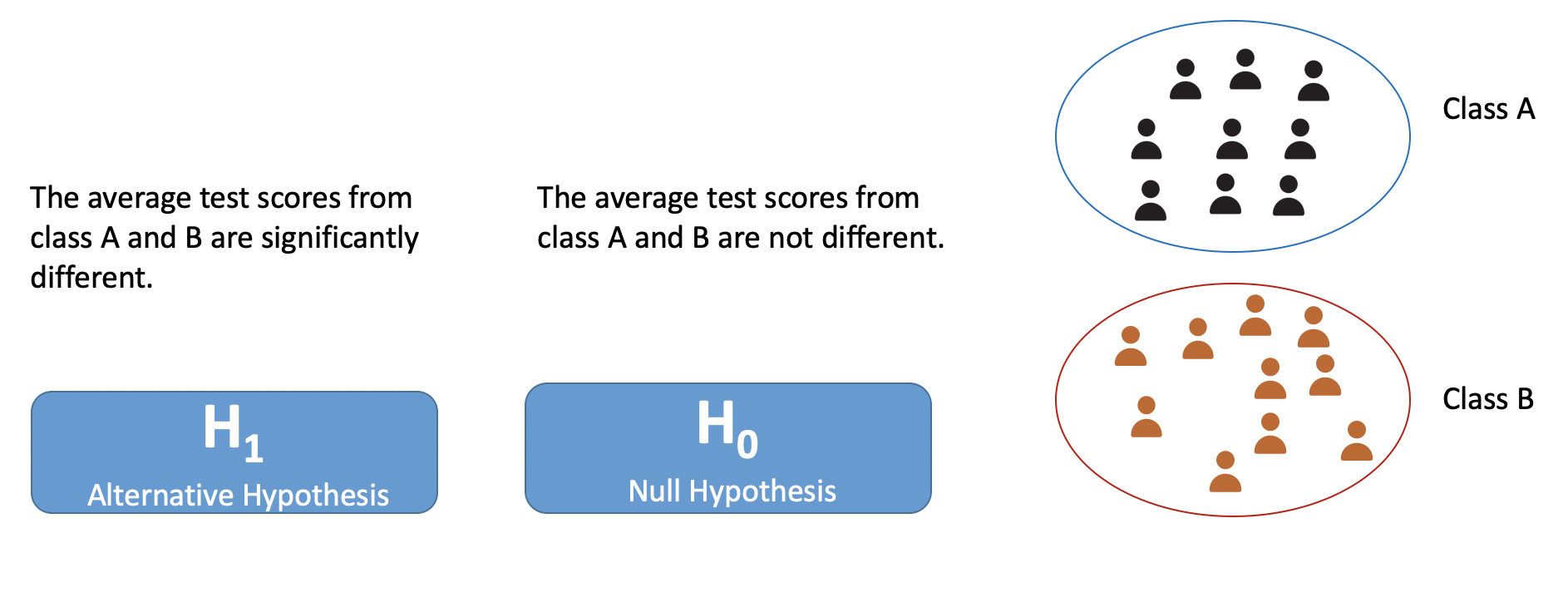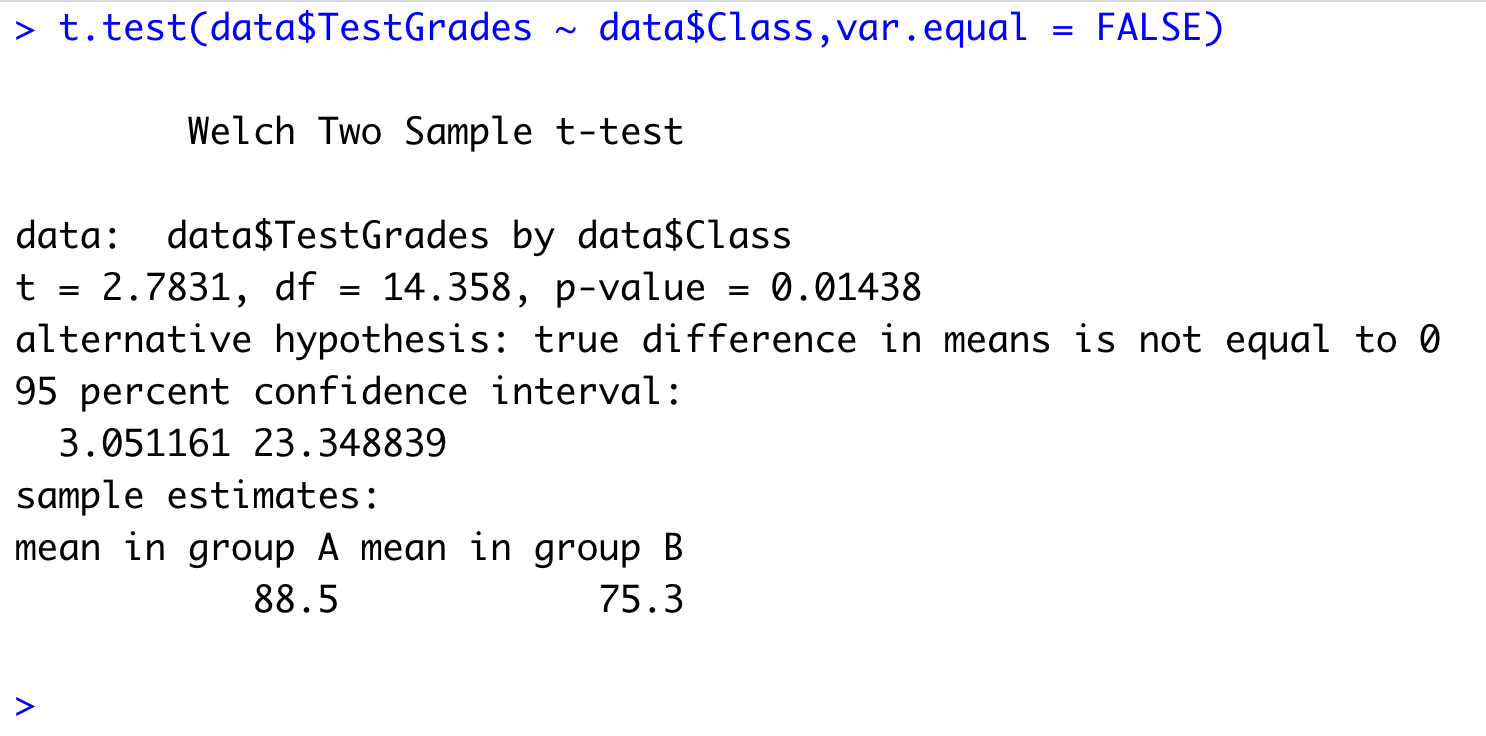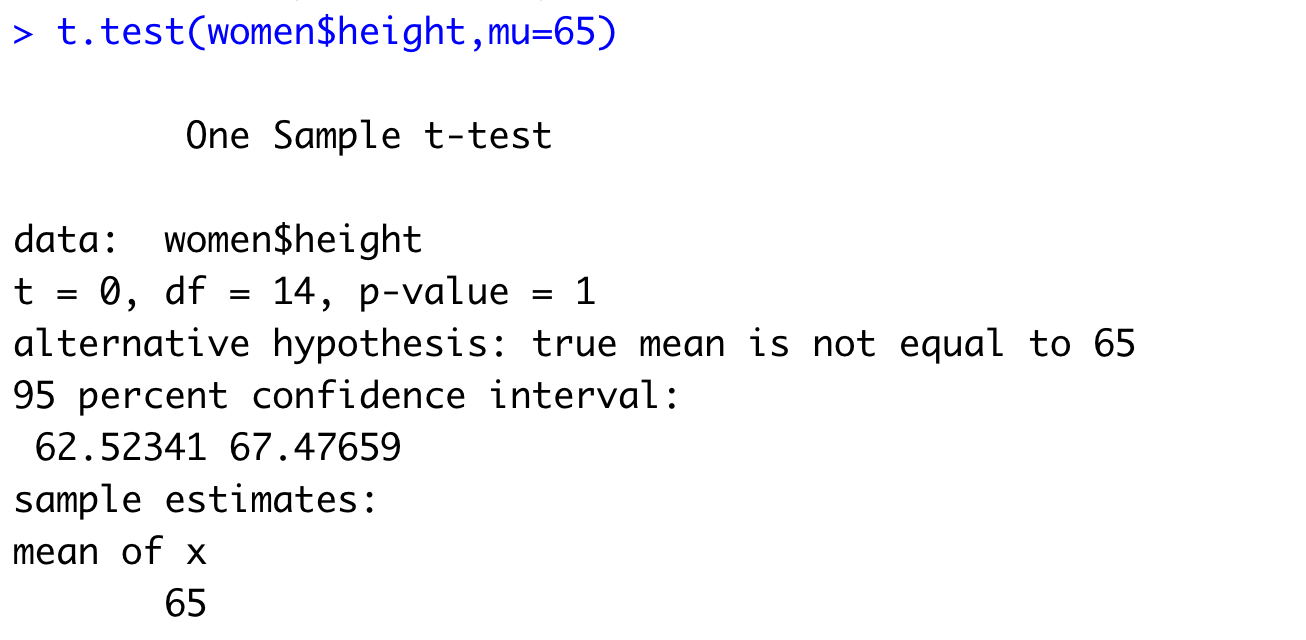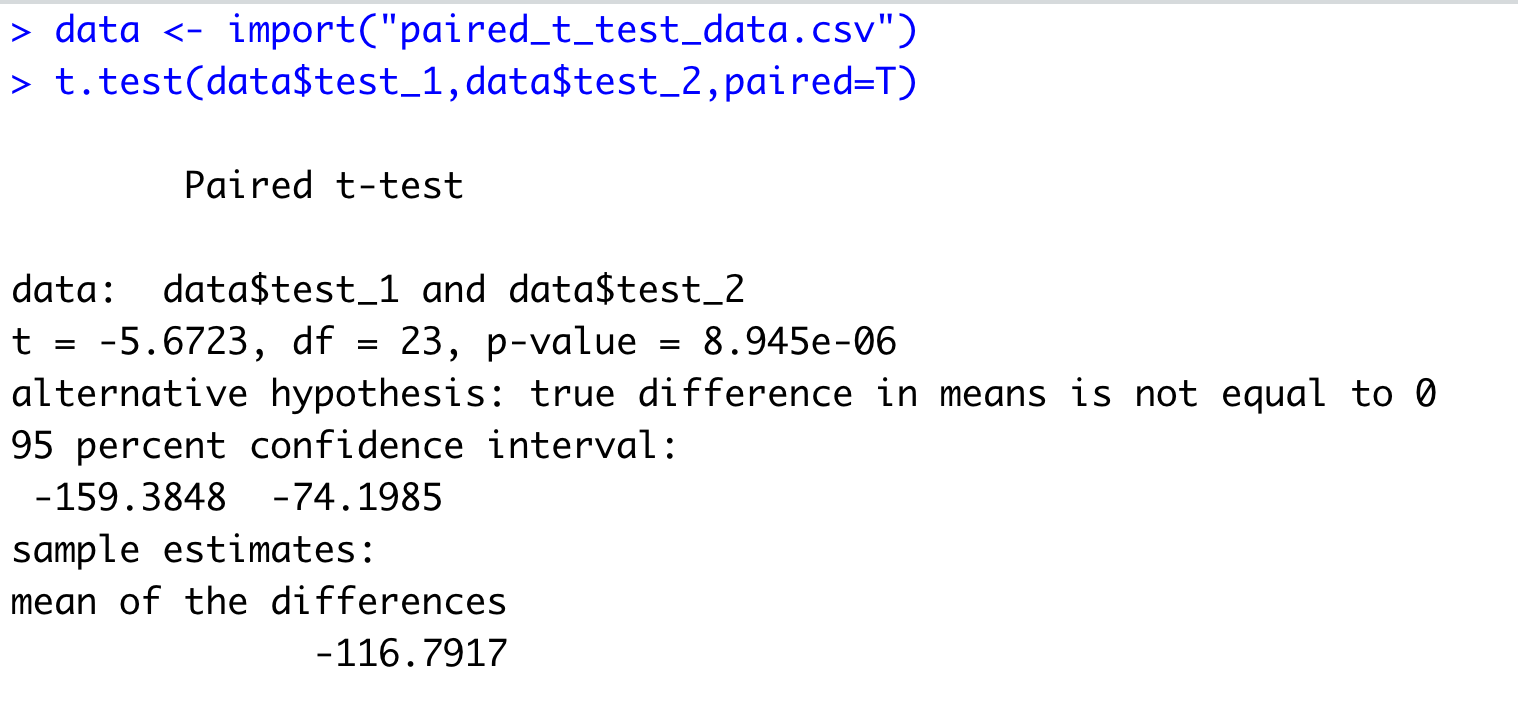This post delves into inferential statistics and explains two different statistical test. Additionally, this post also talks about the need of performing these tests along with their suitability based on available data.
In particular, this post tackles the following three questions.
- Why we do the statistical test?
- How to do it?
- When to do which test?
Why we do the statistical test?
As we have already discussed that we often do not have access to the entire population. Instead, we have access to a small portion of the population known as a sample. We use this sample to infer knowledge about the population.
Following are a few examples to explain it further.
- We collected a sample of height data from students studying in university X. We computed the average of our sample and obtained the average height of students in our sample. Now we want to test whether the average height found in our sample is the same for the population.
- We collected two samples from two universities’ students’ salaries. We want to see is there any difference between the average salary between two universities or not.
- We collected two samples of test scores from the same classroom at the start of the semester and end of semester. We want to see students whether the students’ test scores’ were improved significantly or not.
- We collected a salary sample of people working in Tallinn with their education levels (e.g., primary, secondary, bachelors, master, doctorate). We want to test is there any significant difference in salary among these various levels of education levels.
All these aforementioned examples illustrate some of the cases where we can apply the statistical test to test our assumption or guess (aka. hypothesis). One thing to note here is we are not just interested in finding knowledge for our sample, we want to rather use it to gain knowledge about the population.

The above diagram gives a pictorial representation of what we have just talked about. There are two classes- A and B. Let’s say there are 100 and 80 students in class A and B, respectively. We collected a sample of student’s test scores data from both classes. In our sample, we have test scores for only a few students (let’s say 35-40). We computed the average for both the samples and found that the sample-1 mean is higher than sample-2 mean. This is what we learned from our sample. Now, we want to see is it also the same for the population (classroom-A average is higher than classroom-B average test scores or not). Here comes the statistical test. We use them to infer knowledge about the population based on collected sample data.
How to do it?
We will cover one sample t-test, independent sample t-test, paired t-test, and ANOVA in R.
Independent sample t-test
We do this test when we have two independent samples and we want to compare a statistic for these two groups. For example, we want to compare the average salary of students working part-time from two different universities. In this case, we have two samples collected from different universities. These samples are independent because they contain data of different people.
Make sure the following assumption in your dataset when you do a t-test
- Continuous dependent variable.
- Categorical independent variable for grouping.
- Independent data samples
- Dependent variable has a normal distribution.
- Each group has the same variance.
We will look at the above assumptions with the help of an example. Let’s say we have test scores from two classes: A and B. Now we want to test whether the difference between these two classes’ test scores is significant or not.
| Class | TestScore |
|---|---|
| A | 99 |
| A | 93 |
| A | 81 |
| A | 92 |
| A | 89 |
| A | 80 |
| A | 88 |
| A | 81 |
| A | 100 |
| A | 82 |
| B | 98 |
| B | 66 |
| B | 86 |
| B | 62 |
| B | 78 |
| B | 87 |
| B | 77 |
| B | 60 |
| B | 60 |
| B | 79 |
You can see the dataset has one continuous variable (TestScore: Numeric type) and one class variable as the grouping variable. This class variable tells the classroom from which the scores are collected.
Assumptions
Continuous dependent variable: the dataset has continuous dependent variable (testScore).
Categorical independent variable: the dataset has a class variable which is a categorical variable(a variable that has categories of value).
The independence assumption can only ensure while data collection. We assume here that the data were collected independently.
Normal distribution: We can plot the test scores for each class and check for
bell shape.library(lattice) library(rio) # load dataset data <- import('data-file-name') # plot the distribution densityplot(~ data$TestScore|data$Class)
Same variance in both groups (class A and B): We will compute the variance in both groups. We can use the dplyr package for computing variance class-wise.
data %>% group_by(Class) %>% summarise(var(TestScore))The variance for Class A and B are following
Class Variance A 55.8 B 169 As we can see the variance is not the same and the difference is not small.
- If the variance is the same, we will use Student’s T-test.
- If the variance is not the same then we will use Welsh T-test.
In our dataset, the variance is not the same therefore we will apply Welsh t-test.
Performing the test
We will first set up our hypothesis. We want to test that is there any difference between the test scores of class A and B. We will follow the below steps
- State Null and alternative hypothesis
- Decide significance level \(\alpha\)
- Perform test
- Check the
p-valueand decide ‘whether to reject the null hypothesis or not’
Now, let’s talk about each step in detail.
The first step is to formulate the null and alternative hypotheses. What are those? We specify what we want to test. For example, in our class’s test scores dataset, we want to test that the average test scores from two groups are different. It will become our alternative hypothesis. The null hypothesis is a hypothesis of no difference. In other words, the opposite of what we want to test. The below diagram is showing our null and alternative hypotheses.

The second step to decide the level of significance (\(\alpha\)). You can choose one of the following: 1%, 1%, 5%. For our example, let’s select as 5% or .05.
The third step is to perform the test and obtain the p-value.
p-value =< \(\alpha\) : \(H_1\) hypothesis
p-value > \(\alpha\) : \(H_0\) hypothesis
We will perform the t-test on our dataset in R.
t.test(data$TestScore ~ data$Class, var.equal = FALSE)We use t.test() function from R. We have specified the test score and class variable. Here, the test score is the dependent variable and class is an independent variable. We have also specified that the variance of groups is not equal. It automatically selects Welsh t-test when we tell that the variance among groups is not the same.

In the results, we can see p-value. We will compare it with \(\alpha\). We can see that the p-value is less than .05 (or our selected level of significance). Hence, we say that null hypothesis is rejected and the alternative hypothesis can be accepted. From the results, we can also see that group-A mean is higher than group-B. We can say that the average test score from class A is significanlty higher than the average test score from class B.
One sample t-test
This is the most basic scenario for a t-test. In our list of examples, the first example is where we use one-sample t-test. So if you have a single sample and you want to test whether the statistic (e.g., mean, variance, standard deviation) obtained from the sample is population statistic or not.
For this test, we will use women dataset from the R datasets package. This dataset has two attributes- height and weight of American women. We want to see whether the average height of American women is 65 (this is what we got from our sample) or not.
So here we set up the following hypothesis
H_0 : Average height is same as 65 (hypothesis of no difference)
H_1: Average height is not the same as 65.
Don’t forget to test the assumptions for the t-test. In this case, we will go for testing the distribution is normal or not. You can plot the histogram or density plot and check for bell shape.
We then set the level of significance as 5% (or .05)
Let’s perform the test now.
# load datasets package
library(datasets)
t.test(women$height,mu=65)
From our results from the t-test, we can see that the p-value is not less than .05 which means we can not reject our null hypothesis.
Paired t-test
Let’s think about the third example which we have discussed in the start.
We collected two samples of test scores of same classroom at the start of the semester and end of the semester. We wanted to test whether the students’ test scores’ were improved significantly or not.
For this exercise, we have the following dataset of test scores of the same students at the start of the lecture and end of the lecture.
| test-1 | test-2 |
|---|---|
| 175 | 296 |
| 329 | 376 |
| 238 | 309 |
| 60 | 222 |
| 271 | 150 |
| 291 | 316 |
| 364 | 321 |
| 402 | 447 |
| 70 | 220 |
| 335 | 375 |
| 300 | 310 |
| 245 | 310 |
| 186 | 282 |
| 31 | 317 |
| 104 | 362 |
| 132 | 338 |
| 94 | 263 |
| 38 | 138 |
| 62 | 329 |
| 139 | 292 |
| 94 | 275 |
| 48 | 150 |
| 68 | 319 |
| 138 | 300 |
So data were collected from the same students. In this case, we will apply the paired t-test to test whether there is any improvement in students’ test scores after attending the lecture or not.
We first need to test the assumptions (Skipped for it. You can check the assumptions here)
We will set-up our hypothesis
H_0 : There is no difference in students’ test performance before and after the lecture (null hypothesis)
H_1 : There’s is a difference in students’ test performance before and after the lecture.
Then, we would set the level of significance as 5% (.05).
We will perform the test now using the same function but this time we specify the paired parameter as TRUE.

In the results, if we look at the p-value and that is .00000894. This value is smaller than \(\alpha\) which means we can reject the null hypothesis. We accept the alternative hypothesis.
ANOVA
ANOVA or ANalysis Of VAriance test has its usage in a different scenario and here we are going to talk about the most basic one. We use an independent sample t-test when we have only two groups but when we have more than two groups we employ ANOVA test.
Let’s take an example. We have a diet dataset (you can download it from here). This dataset has attributes person id, gender, height, diet, weight before taking diet, weight after taking the diet. There were three different diets were given. We want to test whether the diet has any impact on weight loss or not.
So first we compute the weight loss for each participant.
> data <- import('anova_test_dataset_diet.csv')
> str(data)
'data.frame': 78 obs. of 7 variables:
$ Person : int 25 26 1 2 3 4 5 6 7 8 ...
$ gender : int NA NA 0 0 0 0 0 0 0 0 ...
$ Age : int 41 32 22 46 55 33 50 50 37 28 ...
$ Height : int 171 174 159 192 170 171 170 201 174 176 ...
$ pre.weight : int 60 103 58 60 64 64 65 66 67 69 ...
$ Diet : int 2 2 1 1 1 1 1 1 1 1 ...
$ weight6weeks: num 60 103 54.2 54 63.3 61.1 62.2 64 65 60.5 ...data$weightLoss <- data$pre.weight - data$weight6weeksNow we will consider two attributes for our ANOVA test: weightLoss and type of diet.
Following are assumptions for the ANOVA test
- The dependent variable (weightLoss in our example) is normally distributed in each group (diet types in our example).
- The variance of the dependent variable is the same for all groups of the independent variable.
- Independence data samples.
We use aov() function in R to perform the ANOVA test.

Here, you need to look for Pr(>F) column that is p-value for the ANOVA test. We can see this value is smaller than .05 (5% level of significance) and even also than .01 (1% level of significance). We can say the null hypothesis is rejected. You can refer to this link for a detailed analysis of the same.
When to do which test?
You might be already wondering why we have so many tests and how would I know when to apply which test. To simplify it, you can refer to the following
You have a single variable (continuous type or numeric in R) that you want to investigate and you are interested in finding some knowledge about the population on that variable.
One sample t-test
You have two variables- one continuous and another with categories. The number of categories is two.
Independent Sample t-test
You have the same scenario as above but now you have a second variable with more than two categories.
ANOVA
You have two variables (both continuous) containing data collected from the same participants.
Paired t-test